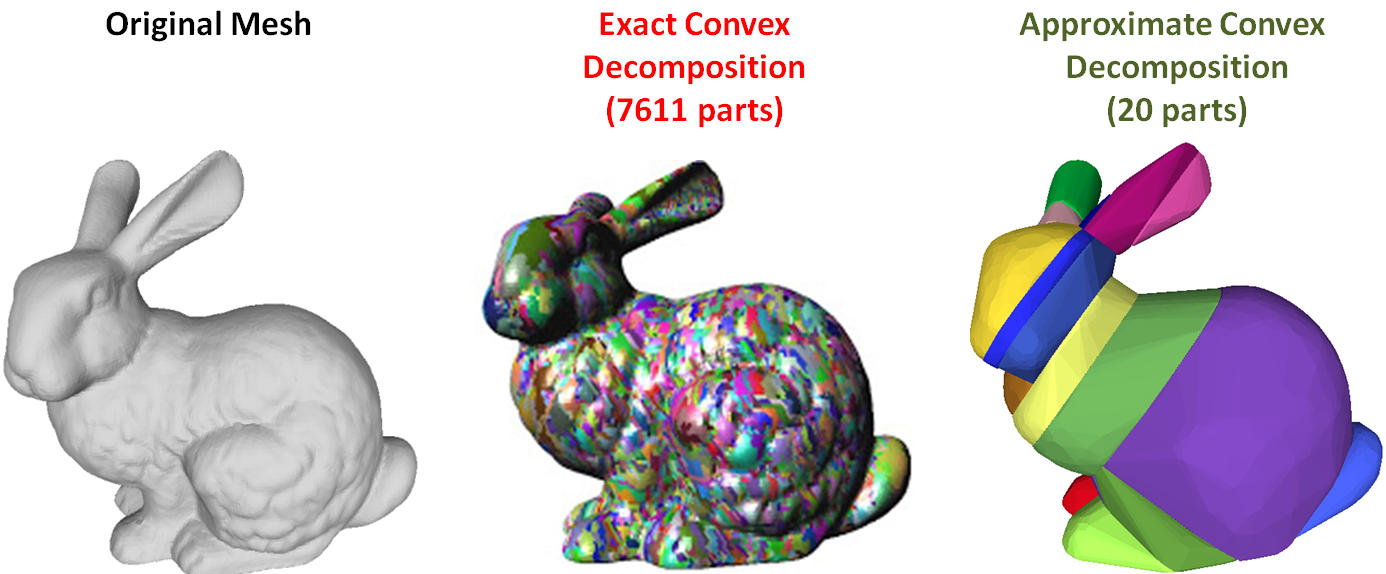The V-HACD library decomposes a 3D surface into a set of "near" convex parts. Within Unity this means we can calculate accurate convex mesh colliders, with correctly wrapped concave regions.
-
Using Unity 2020.2 or later, open the Package Manager from
Window->Package Manager. -
In the Package Manager window, find and click the + button in the upper lefthand corner of the window. Select
Add package from git URL.... -
Enter the git URL for the desired package. Note: you can append a version tag to the end of the git url, like
#v0.4.0or#v0.5.0, to declare a specific package version, or exclude the tag to get the latest from the package'smainbranch.https://github.com/rorygames/VHACD.git?path=/com.rorygames.vhacd -
Click
Add.
To install from a local clone of the repository, see installing a local package in the Unity manual.
Complex colliders can be used to calculate the colliders for an individual mesh, or can combine every single mesh within the child objects of the hierarchy.
- Add a
Complex Collidercomponent to your object. - Choose your
Collider Quality.- Custom quality allows you to fully control all the options, but is significantly more confusing.
- Press either of the calculate buttons, depending on your current setup.
- The interface will disable the options that are unavailable.
- Your collider will then be calculated and stored into a scriptable object within your project.
- This allows you to quickly re-use the asset on other instances of your mesh across your scene.
- No runtime compilation
- I have not tested it, nor do I plan to support it.
- Certain parameter setups can cause significantly long processing times
- This is nowhere near as fast a simple mesh collider, it is designed to be more accurate.
Collision detection is essential for realistic physical interactions in video games and computer animation. In order to ensure real-time interactivity with the player/user, video game and 3D modeling software developers usually approximate the 3D models composing the scene (e.g. animated characters, static objects...) by a set of simple convex shapes such as ellipsoids, capsules or convex-hulls. In practice, these simple shapes provide poor approximations for concave surfaces and generate false collision detection.
A second approach consists in computing an exact convex decomposition of a surface S, which consists in partitioning it into a minimal set of convex sub-surfaces. Exact convex decomposition algorithms are NP-hard and non-practical since they produce a high number of clusters. To overcome these limitations, the exact convexity constraint is relaxed and an approximate convex decomposition of S is instead computed. Here, the goal is to determine a partition of the mesh triangles with a minimal number of clusters, while ensuring that each cluster has a concavity lower than a user defined threshold.
| Parameter name | Description | Default value | Range |
|---|---|---|---|
| resolution | maximum number of voxels generated during the voxelization stage | 100,000 | 10,000-64,000,000 |
| depth | maximum number of clipping stages. During each split stage, all the model parts (with a concavity higher than the user defined threshold) are clipped according the "best" clipping plane | 20 | 1-32 |
| concavity | maximum concavity | 0.0025 | 0.0-1.0 |
| planeDownsampling | controls the granularity of the search for the "best" clipping plane | 4 | 1-16 |
| convexhullDownsampling | controls the precision of the convex-hull generation process during the clipping plane selection stage | 4 | 1-16 |
| alpha | controls the bias toward clipping along symmetry planes | 0.05 | 0.0-1.0 |
| beta | controls the bias toward clipping along revolution axes | 0.05 | 0.0-1.0 |
| gamma | maximum allowed concavity during the merge stage | 0.00125 | 0.0-1.0 |
| pca | enable/disable normalizing the mesh before applying the convex decomposition | 0 | 0-1 |
| mode | 0: voxel-based approximate convex decomposition, 1: tetrahedron-based approximate convex decomposition | 0 | 0-1 |
| maxNumVerticesPerCH | controls the maximum number of triangles per convex-hull | 64 | 4-1024 |
| minVolumePerCH | controls the adaptive sampling of the generated convex-hulls | 0.0001 | 0.0-0.01 |
For feature requests, bugs, or other issues, please file a GitHub issue.






